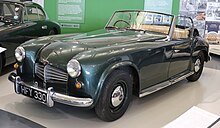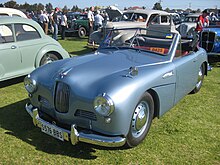Richard Mead Coach Building
| Richard Mead Coach Building | |
|---|---|
| legal form | |
| founding | 1947 |
| resolution | ? |
| Seat | Dorridge , UK |
| management | Richard Mead |
| Branch | Body shop |
Richard Mead Coach Building ( Mead for short ) was a British manufacturer of automobile bodies . In the 1940s and 1950s, Mead built a few individual pieces, some with an unusual history, as well as at least one small series. After ceasing the body shop, the company worked as a service provider for the automotive industry.
Company history
Richard Mead was the founder of the company. His father, Frederick William Mead, founded and managed the car manufacturer Rhode Motor in Birmingham from 1921 to 1931 , and in the 1930s he ran the coachbuilding company Meredith Coachcraft . There was no direct relationship between Meredith and Richard Mead Coach Building.
Richard Mead's workshop was in the small town of Dorridge in central England . Mead worked in modest circumstances. The factory building was described as a dilapidated hut with a roof that was heavily permeable to rain. Mead probably built or processed no more than 15 to 20 bodies in five years; larger series production did not materialize. The body shop ended in the first half of the 1950s.
In the following years Mead continued to operate as a service provider for Abbey Panels . The company completed and painted body shells (so-called bodies-in-white ) that Abbey had manufactured for Jaguar , among others . Most recently Richard Mead ran an auto repair shop. Their existence is documented until the 1990s.
Cars with Mead superstructures
Tickford bodies
Immediately after the end of World War II , small businesses in Britain in particular had significant difficulties in obtaining metals for further processing. Richard Mead circumvented the problem by using bodies in the early years that had been made before the outbreak of war. Until the late 1940s, he processed body shells that the established supplier Tickford in Newport Pagnell had built for the MG SA in 1938 or 1939 .
The MG SA, presented in October 1935, was a large, luxurious car based on the Wolseley 21 "Super Six" and competed with vehicles from Swallow Sidecars (later: Jaguar). It was initially available as a four-door sedan and as an open four-door tourer with a body supplied by Charlesworth . From 1937 MG also added a two-door Drophead Coupé to its range, the body of which came from Tickford. The Tickford Cabriolet was considered the most successful of the three SA versions and, although it was more expensive, sold better than the Charlesworth version. When MG ceased production of the SA in 1939, not all of the bodyshells that Tickford had made in the meantime had been installed. The over-production bodies remained at the Tickford plant during the war. In 1947 Mead took over some of these leftover bodies and built them on Alvis chassis and, in one case, a Bentley chassis.
Alvis
The Alvis TA 14 is a luxury vehicle developed from the pre-war model 12/70 , which was offered in the factory from 1945 with new bodies from Mulliners (sedan), Carbodies and Tickford (both Drophead Coupés ). The convertible bodies of the first post-war generation built at Tickford bore strong resemblance to the designs the company had sold to MG before the war. Alternatively, the TA 14 was available as a roadworthy chassis without a body. The rolling chassis were considerably cheaper than those with fully clothed new cars. That is why almost every third TA 14 was sold without a body. They received different bodies that Alvis customers commissioned from independent body construction companies. Richard Mead was one of them. Because Tickford's old MG bodies were stylistically similar to the superstructures that Tickford supplied to Alvis from 1946, a cursory glance gave the impression that the T14s dressed by Mead were current Tickford Drophead Coupés of the post-war generation. In fact, they were significantly cheaper than the new Tickford versions sold directly by Alvis.
The individual Mead superstructures were not completely identical. In some cases, Mead simplified the Tickford bodies. This affected, among other things, the side paneling of the bonnet, which was sometimes designed more simply. The front fenders were partially changed and the side running boards were omitted. For this the doors in the lower area were then lengthened; they reached to the floor of the vehicle. Other superstructures were completely identical to Tickford's MG bodies.
How many TA 14s were made with the Mead version of the Tickford superstructure is not certain. Some sources speak of six, others of eight vehicles. It is also doubtful whether all Mead superstructures were really based on leftover Tickford bodies. One source assumes that old bodies were only used in three cases, while the remaining Mead bodies were replicas of the Tickford design.
Bentley
Mead built another remaining MG body from Tickford on the chassis of a Bentley 8 liter (chassis number YM5033) produced in 1931 . The Bentley was originally dressed as a limousine by HJ Mulliner & Co. A new owner commissioned Mead in 1948 to shorten the chassis and give it a convertible body. The main body of the Tickford body remained unchanged, although some adjustments were necessary in the area; this affected the fenders, among other things. Work on the car dragged on until 1953. In 2015 the car was exhibited to the public.
Marauder
The goal of a larger series production pursued Mead from 1949 when he worked with the Marauder Car Company , which was also based in Dorridge. Behind the project were the former Rover engineers George Mackie, Peter Wilks and "Spen" King . The first Marauder, the Model A , was an open sports car with the drive technology, the chassis and the shortened chassis of the Rover P4 . Richard Mead was involved in the development of the sports car from the start. The Marauder owners Mackie and Wilks had known Mead for a long time, and they purposefully moved their headquarters to the immediate vicinity of Mead's workshop. Mead designed the body of the Marauder Roadster. It was planned that his company would also manufacture the bodyshells for the series vehicles in the future. But it didn't come to that. Mead built the prototype. It is unclear whether the bodies for the first one or two series models were also produced by Mead; the sources on this are inconsistent. It is certain that Abbey Panels in Coventry took over the production of the series bodies in 1950 and, in any case, produced the vast majority of the 15 Marauder bodies.
Jowett Jupiter
Mead's biggest single order as a body manufacturer was a small series of bodies for the Jowett Jupiter , which appeared in 1950 . The Jupiter was the sports car version of the four-door Javelin sedan introduced by Bradford-based automaker Jowett in 1946. The chassis of the Jupiter was developed by the racing car manufacturer ERA with the help of the German engineer Robert Eberan von Eberhorst . After initial planning, Jowett wanted to sell the Jupiter's roadworthy chassis for £ 500 each; Customers should purchase the bodies from independent body manufacturers according to their own ideas. Jowett only implemented this concept in the first 75 series vehicles; thereafter, the cars were given a standardized factory body supplied by Fisher and Ludlow , which made them cheaper than the early models with individual bodywork. The body manufacturers who clad Jowett-Jupiter chassis included the continental European companies Beutler , Ghia Aigle , Worblaufen and Farina, numerous small British companies. Mead was one of them. It is believed that Mead produced a total of six superstructures for Jupiter. No other independent manufacturer achieved such a large number of Jupiter structures. Mead's design is characterized by smooth, pontoon-style lines that made the car appear more modern than the later factory body, which had pronounced fenders and deep side windows.
Bristol
In 1950 Mead dressed the chassis of a Bristol 401 (chassis number 401895) as a convertible. Meads Bristol was one of only twelve vehicles in the 401 range to be built by an independent body builder. Whether the chassis 401895 was initially equipped with the factory body designed by Touring or whether Bristol Cars delivered it as a rolling chassis without a body is not clear. The last note on the Mead-bodied 401 is from 1992; at the time the car was auctioned in London for £ 8,580.
More unique pieces
In the literature it is often assumed that Mead built a few more individual pieces on chassis from different manufacturers. However, this is not specified in more detail. At least one roadster body Meads for a Lea-Francis 14 hp is occupied .
literature
Nick Walker: A – Z of British Coachbuilders 1919–1960 , Shebbear 2007 (Herridge & Sons Ltd.) ISBN 978-0-9549981-6-5
Remarks
- ↑ Tickford had supplied very similar bodies in the prewar period for the Rover models 14 and 16 ; s. David Culshaw: Alvis three liter in detail: TA 21 to TF 21 1950–67, Herridge and Sons, Beaworthy, Devon, England, 2003, ISBN 0-9541063-2-6 , p. 122.
Web links
Individual evidence
- ^ WB: Forgotten makes, No 87: The Rhode . Motorsport Magazine, November 1989, p. 61.
- ↑ Nick Walker: A – Z of British Coachbuilders 1919–1960 , Shebbear 2007 (Herridge & Sons Ltd.) ISBN 978-0-9549981-6-5 , p. 145.
- ↑ a b Malcolm Bobbitt: Rover P4 . Veloce Publishing Ltd, 2016, ISBN 9781845849580 , p. 108.
- ↑ a b c d e Nick Walker: A – Z of British Coachbuilders 1919–1960 , Shebbear 2007 (Herridge & Sons Ltd.) ISBN 978-0-9549981-6-5 , p. 202.
- ^ NN: Brooklands . Motorsport Magazine, July 1994, p. 72.
- ^ Rainer W. Schlegelmilch, Hartmut Lehbrink: Englische Sportwagen , Könemann, Cologne 2001, ISBN 3-8290-7449-2 , p. 110 (themed there for the Healey Silverstone).
- ^ The MG SA on the MG Owners Club website (accessed on 19 September 2019).
- ↑ David Culshaw: Alvis three liter in detail: TA 21 to TF 21 1950–67 , Herridge and Sons, Beaworthy, Devon, England, 2003, ISBN 0-9541063-2-6 , p. 22.
- ^ John Fox: Alvis Cars 1946-1967: The Post-War Years , Amberley Publishing Limited, 2016, ISBN 9781445656311 , p. 16 f.
- ↑ Description and illustration of a TA14 with Mead structure on the website www.brightwells.com (accessed on September 18, 2019).
- ↑ Forum for the Alvis TA 14 with Mead structure on the website www.coachbuild.com (accessed on September 18, 2019)
- ↑ Description and illustration of the car on the website www.vintagebentleys.org as of 2009 (accessed on September 18, 2019).
- ↑ Image of the car on the website www.ritzsite.nl (accessed on September 18, 2019).
- ↑ a b History of the Marauder Car Company on the website www.gracesguide.co.uk (accessed September 20, 2019).
- ^ Roger Gloor: All cars of the 50s , Motorbuch Verlag 2007, ISBN 978-3-613-02808-1 , p. 225.
- ^ David Culshaw, Peter Horrobin: The Complete Catalog of British Cars 1895-1975 , Veloce Publishing Ltd, 1997, ISBN 9781874105930 , p. 412.
- ↑ Nick Walker: A – Z of British Coachbuilders 1919–1960 , Shebbear 2007 (Herridge & Sons Ltd.) ISBN 978-0-9549981-6-5 , p. 54.
- ^ Roger Gloor: All cars of the 50s , Motorbuch Verlag 2007, ISBN 978-3-613-02808-1 , p. 202.
- ^ Rainer W. Schlegelmilch, Hartmut Lehbrink: Englische Sportwagen , Könemann, Cologne 2001, ISBN 3-8290-7449-2 , p. 172.
- ^ Paul Clark, Edmund Nankivell: The Complete Jowett History , Foulis Haynes, 1991.
- ↑ Sales advertisement for a vehicle registered in 1953 on the website classiccars.brightwells.com (accessed on September 19, 2019).
- ↑ Auction report of the auction house Christies from September 12, 1992 (accessed on September 20, 2019)
- ↑ Sales notification on the website of the auction house H&H (accessed on September 20, 2019).




